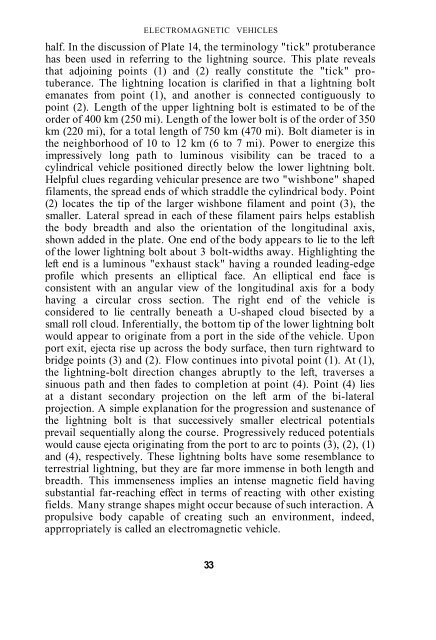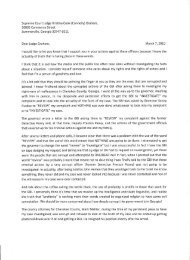Ringmakers of Saturn PDF - Patrick Crusade
Ringmakers of Saturn PDF - Patrick Crusade
Ringmakers of Saturn PDF - Patrick Crusade
You also want an ePaper? Increase the reach of your titles
YUMPU automatically turns print PDFs into web optimized ePapers that Google loves.
ELECTROMAGNETIC VEHICLES<br />
half. In the discussion <strong>of</strong> Plate 14, the terminology "tick" protuberance<br />
has been used in referring to the lightning source. This plate reveals<br />
that adjoining points (1) and (2) really constitute the "tick" protuberance.<br />
The lightning location is clarified in that a lightning bolt<br />
emanates from point (1), and another is connected contiguously to<br />
point (2). Length <strong>of</strong> the upper lightning bolt is estimated to be <strong>of</strong> the<br />
order <strong>of</strong> 400 km (250 mi). Length <strong>of</strong> the lower bolt is <strong>of</strong> the order <strong>of</strong> 350<br />
km (220 mi), for a total length <strong>of</strong> 750 km (470 mi). Bolt diameter is in<br />
the neighborhood <strong>of</strong> 10 to 12 km (6 to 7 mi). Power to energize this<br />
impressively long path to luminous visibility can be traced to a<br />
cylindrical vehicle positioned directly below the lower lightning bolt.<br />
Helpful clues regarding vehicular presence are two "wishbone" shaped<br />
filaments, the spread ends <strong>of</strong> which straddle the cylindrical body. Point<br />
(2) locates the tip <strong>of</strong> the larger wishbone filament and point (3), the<br />
smaller. Lateral spread in each <strong>of</strong> these filament pairs helps establish<br />
the body breadth and also the orientation <strong>of</strong> the longitudinal axis,<br />
shown added in the plate. One end <strong>of</strong> the body appears to lie to the left<br />
<strong>of</strong> the lower lightning bolt about 3 bolt-widths away. Highlighting the<br />
left end is a luminous "exhaust stack" having a rounded leading-edge<br />
pr<strong>of</strong>ile which presents an elliptical face. An elliptical end face is<br />
consistent with an angular view <strong>of</strong> the longitudinal axis for a body<br />
having a circular cross section. The right end <strong>of</strong> the vehicle is<br />
considered to lie centrally beneath a U-shaped cloud bisected by a<br />
small roll cloud. Inferentially, the bottom tip <strong>of</strong> the lower lightning bolt<br />
would appear to originate from a port in the side <strong>of</strong> the vehicle. Upon<br />
port exit, ejecta rise up across the body surface, then turn rightward to<br />
bridge points (3) and (2). Flow continues into pivotal point (1). At (1),<br />
the lightning-bolt direction changes abruptly to the left, traverses a<br />
sinuous path and then fades to completion at point (4). Point (4) lies<br />
at a distant secondary projection on the left arm <strong>of</strong> the bi-lateral<br />
projection. A simple explanation for the progression and sustenance <strong>of</strong><br />
the lightning bolt is that successively smaller electrical potentials<br />
prevail sequentially along the course. Progressively reduced potentials<br />
would cause ejecta originating from the port to arc to points (3), (2), (1)<br />
and (4), respectively. These lightning bolts have some resemblance to<br />
terrestrial lightning, but they are far more immense in both length and<br />
breadth. This immenseness implies an intense magnetic field having<br />
substantial far-reaching effect in terms <strong>of</strong> reacting with other existing<br />
fields. Many strange shapes might occur because <strong>of</strong> such interaction. A<br />
propulsive body capable <strong>of</strong> creating such an environment, indeed,<br />
apprropriately is called an electromagnetic vehicle.<br />
33



